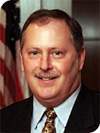The Taxation Straw and the Camel’s Back

Some things are worth higher taxes. But determining which are and which aren’t can’t be done in a vacuum.
The thing about people with strong opinions is that they come easy when you see the world in black and white or right and wrong. But I have to admit, I’m doing some painful soul-searching trying to assess the half-cent sales tax proposed this month for medical research in Jackson County.
Supporters say the tax would generate $40 million a year to support research at Children’s Mercy and Saint Luke’s hospitals, plus the University of Missouri-Kansas City. Right up front, I have no problem with the desire to invest in medical research. Ingram’s for years has heavily covered and endorsed the growing life-sciences sector in this region, and we’ve advocated the Johnson County Educational Research Triangle (JCERT) on the Kansas side. And we collaborate with those organizations—the University of Kansas’ Edwards campus, the new Olathe Innovation Campus for Kansas State University and the KU Cancer Center—on various projects. We’ve thought the Missouri side might follow with a similar plan.
But there are some important distinctions between JCERT and what’s being proposed for Jackson County, Mo.
For one, the idea of JCERT was floated in 2007, and there was a thorough public examination of the proposal and its projected benefits that gave voters a year to decide before they approved it in November 2008. The current Missouri proposal would be rushed through the Jackson County Legislature in less than three weeks, with little more than two months before a November ballot. I hate to be cynical about this, but Washington has been playing this kind of pass-it-before-you-read-it policy-making for years now, and the result has been Obamacare, Dodd-Frank and now, a badly flawed attempt at immigration reform. What’s the rush?
For another, the proposed $40 million that would be raised is nearly three times JCERT’s $15 million annual contribution to the life-sciences cause. How did we get to this level? What makes that the right number? Would there be some benefit to pulling back and ramping it up after we’ve seen signs of initial success? Twenty years is also a long commitment.
My biggest reservation, however, is a personal one. Adding a half-cent to every $1 of goods or services purchased would leave Jackson County and the City of Kansas City south of the river with by far the highest sales tax of any community in the metro area. We need to put that figure into context. And for businesses in KC, that context has the contours of a camel’s back:
• Those of us in a rigged geography near the 2.2-mile streetcar line are being taxed to fund much of that $102 million boondoggle project. Now, they’re already talking expansions. Are we going to be subjected to additional levies to pay for those, as well?
• We’ve seen friends and neighbors pack up their belongings and move west to take advantage of an even more business-friendly tax structure that Kansas put in place last year, and is making even more attractive to those business owners with new changes passed this year. As Kansas City, Mo., and the state lose more businesses and tax base to Kansas, the rest of us here are going to have to pick up that much more of the tax burden.
• We still don’t know what the tax bite would be if the city charges ahead on a $1 billion reconfiguration of Kansas City International Airport. We don’t know what’s going to happen to water and sewer rates with that $25 billion federal consent decree hanging over our heads for a quarter-century’s worth of mandatory system improvements. And we’re paying $14 million a year to cover the tax-receipt deficit for the Power & Light District, which we were promised would operate without public subsidies before opening in 2007.
Bottom line: In addition to the incredible uncertainty injected into the national economy over the past five years, local officials seem to be doing everything they can to pile on. Like others, I’m a competitive guy: Set the rules, show me the playing field, and I’m on it.
But how can any business owner look at all of those moving pieces and make an intelligent decision about where his business can go over the next five years in a climate like this? What will it take to make those in policy-setting positions understand that their goals aren’t taking place in a vacuum? They need to be factored in to a larger economic picture that affects decisions we make about expansion, capital improvements and hiring.
It’s almost as if there’s an invisible hand out there determined to gum up the works for all but the most highly capitalized businesses. And I say that as the son of a former Jackson County assessor—I know exactly what the value of an effective tax structure is for developing business growth and retention.
The kicker is, I support the goals of this proposal. I think Kansas City is uniquely positioned to become a leader in the life sciences. But that includes animal health, which may be the better avenue for distinguishing this region as a center for life-sciences research. Roughly one-third of the companies in that $60 billion sector have facilities or operations between Manhattan, Kan., and Columbia, Mo., and this latest proposal embraces not a single thing that will take advantage of that.
We have longstanding relationships with the organizations that would significantly benefit from Jackson County’s proposal. But to be candid, when well-funded non-profit organizations stand to benefit from forced public participation, rather than this region’s long-demonstrated penchant for philanthropy, I think the playing field has tilted away from what I would consider fair.
Is this the right plan at the right time? It would help to have more questions answered that would eliminate the shades of gray.

Joe Sweeney
Editor-In-Chief & Publisher